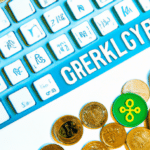There are always exciting new discoveries and announcements in the realm of blockchain and cryptocurrencies. This article will discuss the most recent developments and trends in the blockchain and cryptocurrency markets. Recent developments in this digital ecosystem, such as the growth of decentralized finance (DeFi) and the widespread adoption of blockchain technology, will be discussed in detail. Don’t miss out on any of the breaking news in the rapidly developing fields of blockchain technology and virtual currencies.
- 1. Introduction
- 1.1. Definition of blockchain
- 1.2. Definition of cryptocurrency
- 1.3. Importance of blockchain and cryptocurrency
- 2. Latest Developments
- 2.1. New blockchain platforms
- 2.2. Cryptocurrency market trends
- 2.3. Blockchain adoption in industries
- 2.4. Regulatory updates
- 2.5. Emerging blockchain and cryptocurrency technologies
- 3. Benefits and Challenges
1. Introduction
In recent years, blockchain technology and cryptocurrencies have swept the globe, reshaping how people think about and conduct financial transactions across a wide range of sectors. As a result of the industry’s explosive expansion, there is a never-ending stream of news and changes that enthusiasts and investors must monitor. Recent developments, market movements, legislative shifts, and groundbreaking technologies in the blockchain and cryptocurrency industries will be discussed. Insights into the rapidly changing landscape of blockchain and cryptocurrencies await those who stick around.
1.1. Definition of blockchain
Transactions in the blockchain are recorded and kept track of across a network of computers, or nodes. It is a groundbreaking technology that enables for secure and transparent peer-to-peer transactions without the need for intermediaries like banks or governments. Each purchase is recorded in its own block, and these blocks are linked together to form an immutable ledger of all purchases. The widespread belief in this technology’s transformative potential has contributed to its meteoric rise in popularity. Since the advent of Bitcoin and other cryptocurrencies, blockchain has come to be widely understood as simply shorthand for “digital currency.”
1.2. Definition of cryptocurrency
Cryptocurrency is a digital or virtual currency that employs encryption to facilitate anonymous and secure transactions, regulate the issuance of units, and ensure the integrity of asset transfers. Unlike traditional physical currencies issued by central banks, cryptocurrencies run on decentralized networks known as blockchains. These blockchains employ a distributed ledger system, in which transactions are recorded across a network of computers, or nodes.
Cryptocurrencies offer various advantages over traditional modes of payment. They facilitate instant and safe transactions, do away with the need for intermediaries like banks, and reduce the cost of conducting business. Cryptocurrencies are also immune to censorship and political meddling since they are decentralized.
Bitcoin, the first successful cryptocurrency, was founded in 2009 by an anonymous individual or group going by the name Satoshi Nakamoto. Since then, many additional decentralized digital currency systems have evolved, each with its own set of advantages and applications.
In recent years, the value of cryptocurrencies has skyrocketed, catching the attention of merchants, consumers, and financiers alike. They’ve exploded onto the international stage to disrupt established markets and create new ones. If you’re interested in this dynamic and rapidly developing industry, it’s essential that you keep up with the newest news and developments in the cryptocurrency market.
1.3. Importance of blockchain and cryptocurrency
There has been a meteoric rise in interest in blockchain technology and digital currencies in recent years. Their significance cannot be emphasized, as they have already changed several sectors and will continue to mold the future of business and technology.
The blockchain is a distributed digital ledger that records transactions across several computers and is the underpinning technology of cryptocurrencies like Bitcoin. Its revolutionary features in areas like supply chain management, healthcare, and finance include transparency, security, and immutability.
Bitcoin and other cryptocurrencies are digital currencies that utilize cryptography to ensure private and secure transactions online. It allows for peer-to-peer transactions with reduced fees and quicker processing times by cutting out middlemen like banks.
Blockchain and cryptocurrencies are significant because they have the ability to upend established systems and offer new approaches to old problems. They provide for more autonomy, privacy, speedier transactions, lower prices, and higher efficiency.
In this post, we will analyze the latest events and developments in the world of blockchain and cryptocurrency, highlighting their relevance and the impact they have on many sectors.
2. Latest Developments
It’s important to stay up with the latest news and innovations in the dynamic field of blockchain technology and digital currencies. These new advancements have far-reaching consequences for financiers, corporations, and tech fans alike, and they influence the future of this quickly expanding industry.
One of the most significant developments in recent times is the rising embrace of blockchain technology by established financial institutions. Financial institutions are beginning to see the potential advantages of blockchain technology, such as increased safety, transparency, and effectiveness. Therefore, they are looking into ways to implement blockchain technology inside their current infrastructure.
The development of decentralized finance (DeFi) applications is also significant. DeFi platforms use blockchain technology to offer users the same kinds of financial services that were once only available through middlemen. These platforms enable individuals to lend, borrow, trade, and invest in cryptocurrencies without the need for traditional financial institutions. DeFi’s rising popularity points to a movement toward more open and accessible monetary systems.
Additionally, there is growing interest in combining blockchain with other promising new technologies. Blockchain is being integrated with AI, IoT, and cloud computing to produce ground-breaking applications in many fields. Supply chain management solutions built on the blockchain, for instance, are making huge strides toward greater openness and less fraud in the tracking and verification of commodities.
Furthermore, governments everywhere are investigating the feasibility of central bank digital currencies (CBDCs). Central bank digital currencies (CBDCs) are digital equivalents of national fiat currencies. CBDCs leverage blockchain technology to provide trustworthy and time-saving monetary exchanges. CBDCs are being tested in several countries already, including China and Sweden.
These are some of the most recent innovations in the world of blockchain and digital currencies. It is crucial to keep up with the most recent developments and trends in the technological world. Whether you’re a business owner, investor, or just interested in the future of blockchain technology, being abreast of the latest developments is essential for staying competitive.
2.1. New blockchain platforms
As development in blockchain technology proceeds, novel cryptocurrency platforms emerge. These networks are reshaping many sectors because they increase safety, openness, and productivity. Let’s take a look at what’s new in the blockchain industry.
1.0 Ethereum
Among the most well-known blockchain networks, Ethereum is undergoing a substantial upgrade to its core protocol, which is being referred to as Ethereum 2.0. The goal of this upgrade is to improve network speed and make it more scalable. Ethereum 2.0 will allow for more efficient transactions at lower energy costs by using a proof-of-stake consensus method.
Polkadot is a multi-chain platform that facilitates the smooth cooperation of many blockchains. It aspires to develop a distributed web where many blockchains can safely communicate and share data among themselves. The scalability, security, and interoperability provided by Polkadot’s innovative design make it a compelling option for both developers and enterprises.
Third, Cardano
Cardano is a blockchain network that prioritizes safety and long-term viability. It utilizes a peer-reviewed approach to assure the highest level of security and reliability. The Ouroboros proof-of-stake algorithm developed by Cardano provides a safer and more energy-efficient consensus mechanism. Cardano is positioned to make major advancements in the cryptocurrency sector as a result of continuing initiatives and partnerships.
Four. Solana
Solana is a powerful blockchain environment for dApps and cryptocurrency initiatives. It’s great for high-throughput applications because of the speed and low cost of its transactions. Solana’s innovative consensus mechanism, Proof of History, guarantees fast and reliable transaction verification. Developers and investors are taking notice of Solana because of its expanding ecosystem and user-friendly infrastructure.
Reason #5: Binance Smart Chain
Binance Smart Chain (BSC) is a blockchain technology built by the prominent cryptocurrency exchange Binance. Its purpose is to support DeFi initiatives and distributed applications with a robust and flexible platform. With BSC’s Ethereum Virtual Machine (EVM) compatibility, Ethereum-based apps may be simply migrated to the Binance Smart Chain. BSC has acquired a lot of popularity in the DeFi market thanks to its expanding ecosystem and cheap transactions.
These are just a few of the new blockchain platforms that are making significant strides in the field of digital currencies. We can anticipate other fascinating breakthroughs that will impact the future of blockchain and transform a wide range of sectors as the technology advances.
2.2. Cryptocurrency market trends
The cryptocurrency market has been constantly evolving, with new trends emerging often. The development of blockchain and cryptocurrencies is heavily influenced by these tendencies. The most recent trends in the bitcoin industry will be discussed here.
Decentralized finance (DeFi) has exploded in popularity over the past few years, and it now appears to be the dominant model. It is the process of re-creating conventional monetary systems using decentralized technologies like blockchain and digital currencies. DeFi systems eliminate the middleman in financial transactions by providing services such as lending, borrowing, and trading. There has been a notable rise in the total value of locked-in DeFi projects, which points to the increasing popularity of this technology.
Second, Non-Fungible Token (NFT) Craze: NFTs are making waves in the digital art scene. NFTs are singular pieces of digital property that can stand in for legal title to a specific physical item or chunk of content. By using NFTs, singers, writers, and other creatives can bypass middlemen and offer their wares directly to consumers. There has been meteoric expansion in the NFT industry, highlighted by high-profile deals and partnerships.
Third, widespread interest from institutional investors indicates widespread institutional adoption of cryptocurrency. Traditional financial institutions are looking for methods to include cryptocurrencies like Bitcoin into their business, while companies like Tesla and Square have already made substantial investments in Bitcoin. The bitcoin market will benefit from the increased legitimacy and stability that comes with institutional use.
Several nations are investigating the possibility of adopting CBDCs (Central Bank Digital Currencies). Central banks issue and regulate CBDCs as if they were traditional fiat currencies. These digital currencies promise to increase financial inclusion, cut expenses, and provide a secure alternative to traditional cash. China’s digital yuan initiative has been in the forefront.
As the cryptocurrency industry develops, governments and regulatory agencies are working to set clear regulations and compliance standards, which brings us to our fifth point: regulation and compliance. Investors, fraud, and market stability will all benefit from this tighter regulation. The future of cryptocurrencies is heavily influenced by regulatory changes.
Exciting changes are occurring on many fronts in the bitcoin sector. Some of the most influential forces at work now are DeFi, NFTs, institutional adoption, CBDCs, and regulatory initiatives. These changes represent cryptocurrencies’ continued march toward mainstream financial and social acceptance.
2.3. Blockchain adoption in industries
Blockchain technology is gaining a lot of popularity in a lot of different fields. This groundbreaking technology is being welcomed by areas like as banking, supply chain management, healthcare, real estate, and many more. Blockchain’s rising popularity can be attributed to the fact that it has the potential to improve safety, openness, and effectiveness.
Blockchain technology is radically altering the financial sector’s payment and transfer infrastructure. Blockchain’s distributed ledger and cryptographic protections mean fewer middlemen and cheaper transactions. Additionally, this technology facilitates more rapid international trade and enhances the effectiveness of monetary operations generally.
Blockchain technology is also useful in supply chain management. Companies may monitor the flow of commodities in real time by incorporating blockchain technology into their supply chain networks. This not only improves openness but also aids in the fight against theft, piracy, and counterfeiting. The pharmaceutical and luxury goods industries, in particular, rely heavily on the legitimacy and provenance that blockchain provides.
Blockchain’s ability to safeguard medical records, safeguard patient privacy, and streamline data sharing among healthcare providers is now being explored by the healthcare industry. Blockchain technology allows medical records to be safely kept and accessed by authorized persons, protecting the records from hacking and other forms of data corruption.
Another sector seeing blockchain implementation is the real estate market. Property transactions can be made easier by using blockchain technology, which also removes the need for middlemen and guarantees the reliability and veracity of all recorded data. Blockchain-based smart contracts expedite and lower the cost of title searches, escrow services, and the transfer of real estate ownership.
These are just a few examples of how blockchain is being utilized across sectors. More industries will likely benefit from the technology’s potential to spur innovation and efficiency as it develops and matures.
2.4. Regulatory updates
The future of the blockchain and cryptocurrency industries is heavily influenced by regulatory changes. In response to the rapid development of blockchain technology and digital currencies, governments and regulatory agencies around the world are continuously revising their rules and laws. Some of the most recent changes to the rules are as follows:
1. United States: The Securities and Exchange Commission (SEC) has been closely monitoring the cryptocurrency sector and clamping down on fraudulent initial coin offers (ICOs). They’ve also been trying to clarify the regulatory landscape for blockchain assets and cryptocurrencies.
Second, in Europe, the Fifth Anti-Money Laundering Directive (5AMLD) has been implemented, making it a crime to launder money through a virtual currency exchange or a custodian wallet service. The purpose of this order is to curb the use of cryptocurrencies for illegal purposes like funding terrorism.
Thirdly, China has taken a hard line against cryptocurrency, with a ban on initial coin offerings and the closure of cryptocurrency exchanges. But recent reports have indicated that China may be contemplating the creation of its own state-backed digital currency.
Fourth, Japan: With a robust regulatory framework in place, Japan has emerged as one of the most crypto-friendly countries. The Financial Services Agency (FSA) of the country has been strict in its oversight of cryptocurrency exchanges, taking steps to protect consumers and stop money laundering.
Fifthly, in India, banks are not allowed to work with cryptocurrency enterprises due to a ban from the Reserve Bank of India (RBI). However, this ban was recently abolished by the Supreme Court, delivering a big boost to the cryptocurrency industry in India.
Some examples of recent changes to blockchain and cryptocurrency regulations include the ones listed above. It is essential for companies and investors to keep abreast of the newest information in order to successfully navigate the changing regulatory landscape.
2.5. Emerging blockchain and cryptocurrency technologies
The blockchain and cryptocurrency technologies that are just beginning to emerge are continually pushing the envelope of innovation and reshaping many different markets. These technologies have acquired substantial attention and popularity in recent years, with new innovations and advancements being made routinely. Let’s check out what’s new in the world of blockchain and digital currencies.
One of the most exciting developments in the blockchain sector is DeFi (Decentralized Finance). The plan is to use smart contracts and other decentralized technology to remake conventional financial systems. Without the involvement of third parties, users of DeFi platforms can lend, borrow, trade, and earn interest on cryptocurrency.
Non-Fungible Tokens (NFTs) have become extremely popular in the collectibles and art markets. Proof of ownership and authenticity for these one-of-a-kind digital assets can be found on the blockchain. NFTs have given creative professionals new ways to make money from their work and connect with their fans.
3. Central Bank Digital Currencies (CBDCs): Several central banks around the world are researching the notion of CBDCs. Central banks use blockchain technology to issue and manage digital currencies. The primary goals of CBDCs are to broaden access to financial services, modernize payment infrastructure, and create a trusted and convenient means of exchanging value.
Layer 2 scaling solutions have becoming increasingly popular as blockchain networks like Ethereum struggle with scalability issues. By processing transactions off-chain and leveraging the main blockchain’s security, technologies like state channels and sidechains assist increase transaction throughput and decrease fees.
5. Blockchains with an emphasis on privacy: Security and anonymity are becoming major concerns in the blockchain and cryptocurrency industries. Several initiatives are working on blockchains with a focus on privacy, which would provide users with greater anonymity and security. These innovations seek to resolve privacy concerns while maintaining the veracity and safety of blockchain transactions.
Some of the most recent innovations in the blockchain and cryptocurrency industries are examples we’ve provided above. Exciting new opportunities and potential disruptions in many other industries are on the horizon, thanks to the lightning-fast speed of invention in this space.
3. Benefits and Challenges
Blockchain and Digital Currencies: Pros and Cons
In recent years, both blockchain technology and cryptocurrency have seen a surge in interest and adoption. They present several advantages and prospects, but also their own unique difficulties.
Benefits:
The fact that it is decentralized is a major advantage of blockchain technology. Blockchain removes the need for third parties from the transaction validation and recording process, whereas traditional systems rely on a centralized authority. This improves openness, safety, and safeguards against fraud.
2. Security: Blockchain technology uses powerful cryptography algorithms to secure transactions and data. Each transaction is stored in a block and is permanently linked to all the others in the chain. This provides a very high level of security since it makes it very difficult for hackers to alter the data.
Blockchain-based transactions are faster and more secure than those processed using conventional methods. It saves time and money by doing away with the necessity for human verification and reconciliation in business dealings.
Fourthly, blockchain technology can save firms money by cutting out middlemen and eliminating redundant tasks. It eliminates the requirement for third-party verification and minimizes operational expenditures.
Challenges:
Blockchain networks have difficulty scaling, which is especially problematic when processing a high volume of transactions. In terms of transaction processing speed and capacity, existing technology has its limitations. However, advancements in progress attempt to address these difficulties.
2. Uncertainty in Regulation: Cryptocurrency regulation is still developing in several nations. It is difficult for firms and investors to navigate legal and compliance obligations when there is a lack of clarity in the governing legislation.
3. Power Use: Mining digital currencies, like Bitcoin, is an extremely power-intensive process. Because of this, questions have been raised about the long-term viability of blockchain technology and its influence on the environment.
Fourth, there may be security flaws in the supporting infrastructure and apps, even if blockchain technology itself is safe. Cryptocurrencies and blockchain systems are vulnerable to hacking and phishing assaults and other forms of cybercrime.
Finally, there are several advantages to using blockchain technology and cryptocurrencies, including decentralization, security, efficiency, and savings. Scalability issues, legislative ambiguity, energy usage, and security concerns are just some of the downsides. To ensure widespread adoption and effective application as the technology develops, several obstacles must be overcome.
3.1. Advantages of blockchain technology
Blockchain technology is revolutionary because of the many benefits it delivers. Some of the main advantages are as follows:
First, the blockchain is a distributed ledger that ensures all transactions are public and cannot be altered. Because each transaction is logged on several nodes, it’s extremely difficult to tamper with the records.
Second, blockchain improves security since all data is encrypted, making it impossible to compromise. The use of encryption and consensus algorithms both contribute to the improved safety of the system.
By cutting out middlemen and automating verification processes, blockchain speeds transactions, cutting down on the time and money spent on more laborious methods. Smart contracts streamline operations, doing away with middlemen in the process.
4. Traceability and accountability: Blockchain provides a transparent and traceable system for tracking transactions. Keeping track of everything helps with accountability and decreases the possibility of fraud in supply chain management.
Fifth, Blockchain is peer-to-peer and distributed, therefore there is no requirement for a trusted third party to verify transactions. This peer-to-peer approach assures that no single party has control over the entire network, boosting security and resilience.
Despite these benefits, blockchain technology does have some drawbacks that need fixing.
First, the difficulty of scaling blockchain networks as their user bases expand. For widespread use, blockchain will need to outgrow its current limitations in transaction speed and capacity.
Second, there is a large amount of energy used because validating transactions in blockchain networks is computationally intensive. Finding long-term methods to cut energy use is essential.
Third, legal and regulatory uncertainties: blockchain technology’s regulatory environment is still developing. Organizations and governments face difficulties in adopting blockchain technology due to legal uncertainty and compliance concerns.
The lack of established protocols and compatibility between various blockchain platforms prevents their seamless integration and collaboration.
Concerns concerning privacy and data security have been raised in light of blockchain’s transparency benefits. Finding a happy medium between openness and privacy is essential.
Despite these problems, blockchain technology’s benefits are much greater than its drawbacks. Further development of blockchain technology could revolutionize financial transactions across several sectors.
3.2. Opportunities for financial inclusion
The term “financial inclusion” describes the process by which all people, including the unbanked and the underserved, have equal access to and use of financial services. New possibilities for financial inclusion, especially in poor nations, have emerged with the advent of blockchain and cryptocurrency technology.
The capacity to reach the unbanked is a significant advantage of blockchain and cryptocurrencies. Millions of people are excluded from official financial services because they lack the substantial documentation, credit history, or physical presence typically required by traditional banking institutions. But with blockchain technology, people may establish digital identities and gain access to financial services without having to open a bank account.
Global monetary exchanges can be completed more quickly and cheaply with the help of blockchain-based technologies. When sending money internationally, many people, especially migrant workers, are met with hefty costs and lengthy processing times. Financial inclusion for those who rely on remittances can be improved by using cryptocurrencies and blockchain technology to provide instant, low-cost money transfers.
In addition, blockchain technology permits the development of decentralized loan marketplaces. This helps persons with restricted access to traditional banking institutions to receive loans and credit. By using smart contracts on the blockchain, borrowers and lenders can feel more at ease, fraud can be prevented, and people can establish or improve their credit scores.
Financial inclusion via blockchain and cryptocurrencies has many advantages, but it also comes with some difficulties. Not enough people, especially in developing nations, know about or appreciate the importance of these technologies. To ensure that people can reap the benefits of blockchain and cryptocurrencies for financial inclusion, education and awareness activities are essential.
The regulatory climate for cryptocurrencies is another obstacle. The usage of cryptocurrencies is prohibited or subject to tight regulations in various countries. To promote the development of blockchain-based financial services and guarantee consumer safety, a transparent and helpful regulatory environment is required.
In conclusion, the widespread availability of decentralized ledger technology and digital currencies offers promising prospects for broadening people’s access to financial services. To effectively utilize these technologies and advance more equitable monetary systems, however, the problems of education and oversight must be solved.
3.3. Security and privacy concerns
Blockchain and digital currencies raise important questions about data security and privacy. It is critical to address the possible risks related with blockchain technology and the use of cryptocurrencies as their use continues to grow.
The safety of digital assets is a major issue. To ensure the safety of transactions and data, blockchain technology employs intricate cryptographic algorithms. But there have been hacking and theft incidents that resulted in major losses. Blockchain’s decentralized structure makes it difficult to undo transactions or retrieve stolen cash, heightening the importance of taking precautions to prevent their loss.
The privacy of the users is another area of worry. Blockchain technology has many benefits, including immutability and openness, but it also introduces new risks to users’ privacy. All users can view all transaction records on the blockchain, which might put private data at risk. More stringent efforts to enforce KYC and AML requirements by governments and regulatory organizations only exacerbate this problem.
The broad adoption of blockchain and cryptocurrencies depends on these security and privacy concerns being addressed. Advanced security mechanisms and privacy-enhancing solutions are actively being developed by industry participants. Cybersecurity professionals, blockchain developers, and government agencies must work together to give users and investors peace of mind.
3.4. Scalability issues
One of the biggest worries in the blockchain and cryptocurrency business is scalability. The necessity for a scalable solution is paramount as the use of cryptocurrencies such as Bitcoin and Ethereum continues to rise in popularity. The term “scalability” refers to a blockchain network’s capacity to process a high volume of transactions quickly and reliably.
Increasing transaction throughput is one advantage of fixing scalability problems. More transactions can be performed in the same amount of time on a scalable blockchain network, resulting in faster, more efficient transactions overall. This is vital for widespread use of cryptocurrencies since it facilitates their incorporation into regular financial practices.
However, there are several difficulties that come with scalability. The need for more space to store data and processing power is a problem. As more transactions are uploaded to the blockchain, the amount of space required to keep the complete blockchain also rises. Similarly, as the size of a network grows, so does the amount of computing power needed to process and validate transactions.
Another problem is ensuring decentralization and security. To ensure security and verify transactions, blockchain networks rely on a distributed network of nodes. Maintaining decentralization as the network grows in size is challenging since reaching consensus requires an ever-growing number of nodes. Additionally, managing the security of a scalable blockchain network becomes more complicated, as the attack surface likewise expands with higher scale.
In conclusion, solving scalability problems is vital to expanding the use of blockchain technology and digital currencies. It has advantages, such as higher transaction speed, but it also has drawbacks, such as increased storage and processing demands while yet remaining decentralized and secure. The true promise of blockchain technology will not be realized unless scalable solutions are found.
3.5. Energy consumption concerns
One of the major problems with blockchain and cryptocurrency technologies is their relatively high energy usage. The energy needed to run the networks and do complicated computations is rising as these technologies become more commonplace and popular. This has prompted questions about the long-term viability of blockchain and cryptocurrency infrastructure.
On the one side, blockchain technology’s decentralized structure improves transparency, security, and efficiency across a number of sectors. It could drastically alter industries including banking, logistics, and healthcare. Unfortunately, Bitcoin and other cryptocurrency mining require a lot of power.
Mining requires a lot of computing power since it involves solving complex mathematical puzzles. This makes heavy use of electricity and demands high-powered hardware. Some calculations suggest that the Bitcoin network uses as much energy as many small countries.
High energy usage has serious consequences for the environment. The vast bulk of the energy required for cryptocurrency mining originates from fossil fuels like coal and natural gas, both of which contribute to global warming and greenhouse gas emissions. The mining operation also generates a lot of electronic garbage, which is bad for the environment.
Despite these worries, work is underway to solve the energy issues plaguing blockchain and cryptocurrencies. Proof-of-stake (PoS) is an alternative consensus mechanism being considered by certain blockchain projects to Bitcoin’s proof-of-work (PoW) that uses significantly less energy. Instead of relying on miners to solve computational challenges, Proof-of-Stake (PoS) systems rely on validators who hold a particular quantity of cryptocurrency.
Furthermore, sustainable energy sources are being integrated into cryptocurrency mining processes. Some mining operations are switching to renewable energy sources like solar and wind power. This helps lower long-term operating expenses and has a positive effect on the environment.
In conclusion, there are advantages and disadvantages to using blockchain and cryptocurrencies due to worries over energy consumption. These technologies have many potential benefits, but they also have significant environmental and energy implications that must be properly evaluated and addressed. Blockchain and cryptocurrency systems can have a more sustainable future if we find ways to reduce the negative consequences and transition to renewable energy.
Conclusion
In conclusion, it is essential for those who are interested in the quickly developing blockchain and cryptocurrency business to keep up with the newest developments. The improvements and innovations in blockchain technology and cryptocurrencies have the potential to transform several areas, including finance, supply chain management, and more. Those interested in a particular field can benefit from keeping abreast of recent developments by learning about new initiatives, laws, market trends, and investment opportunities. It is crucial to keep up with the rapidly developing world of blockchain and cryptocurrencies by conducting in-depth study and education.





